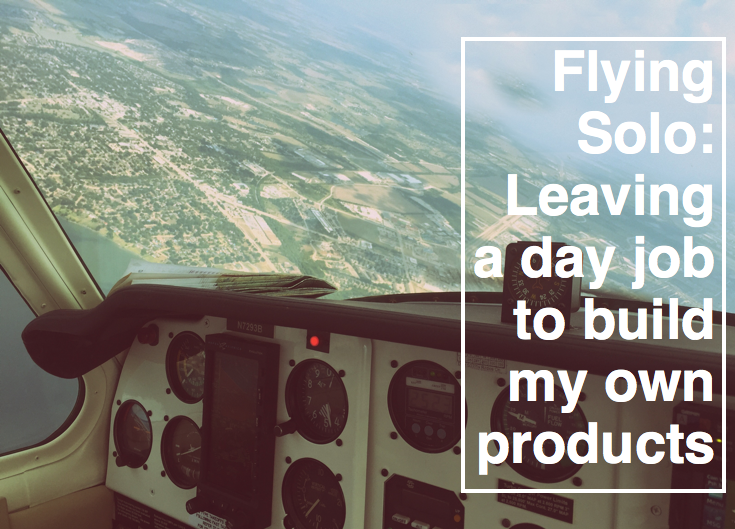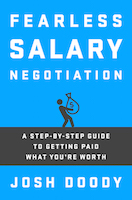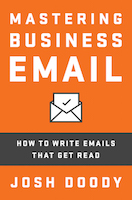I’m unemployed again.
The first question most people ask when they hear that I just put in my notice is, “What are you going to do next?” So let me start with what I’m going to do and then I’ll talk about how I’m going to do it.
This sounds awfully familiar
On the surface, this seems really similar to my situation in 2011:
- I am voluntarily leaving a job…
- …without another job lined up.
- I plan to live on savings.
But that’s where the similarities end. Some things are pretty different this time around:
- I have almost no debt
- I have twice as much cash in the bank as before
- I have income-generating products ready to ship
- I have a plan to make it stick
I have almost no debt
When I quit my job in 2011, my “savings” was an illusion. Yes, I had some cash in the bank, but I also had debt—student loans from undergrad and grad school and a secondary mortgage at a ridiculously-high interest rate.
Had I done the prudent thing at the time, I would’ve kept working and paid off some of that debt with my savings. Instead, I chose to quit my job and live off of that savings, meaning I essentially borrowed money to take time off.
This was a conscious decision—I had just finished MBA school, wasn’t happy with my job, and just wanted to take some time off after working full-time-and-then-some for about 10 years—but still not a prudent decision.
Now, I’ve paid off my student loans and the secondary mortgage. My only remaining debt is my primary mortgage, which I refinanced to 3% and a shorter term—down to 15 years from 30—a couple of years ago. My house is most likely worth more than I owe, so I have paper equity there. I don’t think the reduced liquidity is worth paying off a 3% mortgage, so I don’t plan to pay it off early.
I have twice as much cash in the bank as before
In addition to killing all non-mortgage debt, I’ve saved twice as much as I had in 2011, doubling my runway this time. In 2011, I knew going in that I was just taking a short break from full-time work. Now? This could definitely be longer-term (measured in years) or permanent change.
I have income-generating products ready to ship
I have three projects that I’m working on:
- Fearless Salary negotiation: A step-by-step guide to getting paid what you’re worth
- Mastering Business Email: How to write emails that get read
- TaskBook
Fearless Salary Negotiation: A step-by-step guide to getting paid what you’re worth
Fearless Salary Negotiation is a book, products, and services to help you get paid what you’re worth. “…products and services?” I’m glad you asked! While writing the book, I found that different people have different levels of interest and needs with respect to salary negotiations.
Not in a rush—just want to learn
Some people are happy where they are, and they want to be prepared next time they have an opportunity to improve their salary. For those people, the book is perfect because they can just buy it, skim it, and have that knowledge in their arsenal when the time is right.
In a hurry—need help now
Many people are in a hurry. I get these texts pretty often: “Hey, I have an interview on Monday. Any tips?” and “I just got a job offer, what do I do?” Those people aren’t looking for a book to read, they’re looking for specific tactics they can use right now. For them, I’m creating short video courses to help them prepare for an interview or a salary negotiation in about an hour.
Walk me through this
I may also offer one-on-one coaching for interviews and salary negotiations. I’ve been doing this all year with people I know, and the results have been pretty unbelievable—I have a perfect record of helping friends get a higher salary than they would’ve gotten without my help. The minimum has been $3,000 and they’ve gotten up to $15,000 more annual salary with my help.
Mastering Business Email: How to write emails that get read
Mastering Business Email is a book and products to help professionals write better business emails that get read. This book is for managers who want to improve email communication for their teams, and it will help individuals as well.
How? Different teams and individuals learn in different ways. So I’ll offer a package that includes something for everyone.
The book
The book is short, sweet, and to the point. In about 50 pages, I cover the basics of writing good email and using it effectively. I takes about an hour to read.
The video course
Some people don’t like reading books or learn better with audio to complement the visual. For them, I’m creating a short video course that summarizes the material in the book. So managers can say, “Don’t want to read the book? Ok, watch this 30-minute video and we’ll talk about it in our next team meeting.”
Examples, tools, and presentation materials
Some managers will want to take the material and tweak it to make it their own. So I’ll provide all the sample emails, a one-page cheat sheet for writing effective emails, and the PowerPoint and Keynote templates I use for the video course.
All of those components combined will give managers a powerful toolkit they can use to improve email communication among team members and with clients.
TaskBook
TaskBook is a checklist app to help businesses do all the little things right. It helps businesses coordinate the small tasks that need to be done to ensure the big things get done. It’s great for teaching new employees how to do those things that are done over and over. It helps individuals and teams make sure they do all the little things that need to be done before starting a new project or deploying a new solution.
I launched TaskBook in early 2014. It has exceeded my expectations and has helped many businesses manage their day-to-day tasks. Over 75,000 tasks have been completed in TaskBook so far.
I’ve only been able to work on TaskBook part time since I began building it, and I’m excited to finally jump into it full-time soon.
I have a plan to make it stick
So what’s the plan?
This is my plan for now. It could change. In fact, I would be surprised if it doesn’t change because I have no idea how each of these phases will actually go. But it’s still important to have a plan so I’m forced to justify—even if just to myself—the changes I make.
Here are the highlights:
- Publish the books and book-related products
- Ramp up my marketing efforts to figure out what works for each product
- Generate enough monthly income to cover my cost of living
- Market and relaunch TaskBook
- Build TaskBook into a growing, profitable business
Publish the books and book-related products
Both books are ready to publish. I still need to do some work on the video courses and supporting material, but that work will go quickly because all the source material is already written.
Ramp up my marketing efforts to figure out what works for each product
Once the books are published, I’ll need to spend some time and money figuring out how to find people who will benefit from them. I already have a pretty good idea how to do this, but there’s still a lot of work to be done. To make things more complicated, the books’ audiences don’t overlap very much, which means I’ll essentially have to build two separate marketing programs. I’ve already started building an audience for Fearless Salary Negotiation, so it makes sense to start there. Then I’ll work on Mastering Business Email.
Generate enough monthly income to cover my cost of living
I really don’t want to burn through my savings if I don’t have to. So I’ll work to generate at least enough monthly income to cover my cost of living.
Hopefully my marketing efforts will start ramping things up and generating some income from the two books. My goal is to accomplish this by the end of 2015, but I have absolutely no idea how realistic that is, and it feels ambitious.
Market and relaunch TaskBook
Once I’m covering my monthly cost of living with product income from the books, I can focus on the hard work of finding product-market fit for TaskBook. It has been great for a few customers, but since I’ve never worked on it full-time (or even close to that), it’s been difficult to turn TaskBook into a business. I’ve never had the time to really dig into marketing and research to find new customers and build it out, but now I have the time, so I can really dig in.
Build TaskBook into a growing, profitable business
This means my medium-term goal is a little crazy: Jump onto the “Long, Slow SaaS Ramp of Death”. For the uninitiated, this is how many founders describe the experience of building a Software as a Service (SaaS) app like TaskBook. The mythology is that the process for building and launching a successful software business is something like:
- Build it
- ¿¿¿
- Profit!
It’s much, much harder than that. The “ramp” is the slowly growing (if you’re lucky) revenue curve for the app. This is especially true for bootstrapped software since critical resources (time and money) are so limited. For example: “I’ll spend time this week doing market research to see if this new feature will be useful. If it’s useful, I’ll spend 40 hours next week writing that feature. Once I finish writing the new feature, I’ll spend the following week marketing it and rolling it out.” It’s a long, slow grind of building the software and then marketing it as your revenue slowly ticks up over time.
This is a risky long shot
My plan is a series of parlays, which makes the chances of success pretty slim. If my ultimate goal is to turn my “side projects” into sustainable income-generating businesses that I can live off of, then each of these things needs to happen in turn for the next thing to happen. I could just dive into TaskBook now, but the Long, Slow SaaS Ramp of Death means it could take a long time to build it into a profitable business, and that means I could likely run out of runway (savings) before it took off.
So I need the books to sustain me, allowing me to leave my savings intact. If I can cover my monthly living expenses with the books, then my runway goes from “a year or two” to “essentially infinite”.
If it’s such a long shot, why even bother?
It’s hard to articulate my answer, but there are two main drivers for me:
- I would like to see what I can do on my own
- There’s a chance for a home run
I would like to see what I can do on my own
I think this is something you either sympathize with or you don’t: I want to know what I can do on my own. I’ve spent many years and dollars learning and acquiring skills in both formal and informal educational settings. I’ve intentionally assembled a very well-rounded education so that I could both make useful things and understand how to leverage those things to make a living. Now is the time to pull all of my education and experience together to see what I can do.
There’s a chance for a home run
Although this series of parlays is a long shot, there is a chance for a home run. The books both have a lot of potential to help a lot of people, and TaskBook could be very big if I can find product-market fit. If these things do become big, they could dwarf my income from my day job while giving me much greater control of my time and creative output.
Meanwhile, the downside risk is very well contained because of my savings and lack of debt. If I find that my plan isn’t coming together, I can monitor my spending and decide whether to continue pursuing the plan or to adjust it.
It’s time to strike out on my own to see what I can do. Hopefully this risk pays off.


